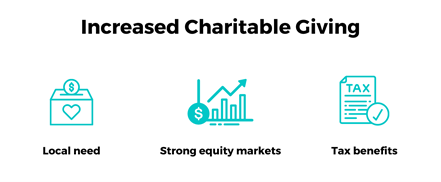
The impulse to help others in need and to share good fortune is universal. It has never been solely the province of the very wealthy; charitable giving at all income levels, whether by donating time, money, or expertise, is a part of many people’s life plan.
When it comes to giving plans that involve donating wealth, the elements of several different dimensions – demographic trends, market performance, advances in financial services, increased need, and potential changes to the tax code – are combining to create unprecedented amounts of giving. And further, the way we give is changing.
We break down the recent data and the reasons behind the changes to philanthropy.
The Need of Last Year Resonated
According to a June 2021 study by Giving USA, American charitable giving hit $471 billion in 2020, a 3.8% increase from 2019. The largest increase in percentage terms was to local giving. Vanguard Charitable reports that homeless shelters and food pantries saw a rise of 147% in donations over 2019. Being able to help and make an impact in your community – the aphorism “charity begins at home” – clearly motivated donors.
But the Trend is Likely to Continue
However, there are many other reasons that played into giving that are likely to continue as we move forward in recovery. This will likely keep charitable dollars flowing. The more than decade-long strong performance of the equity markets means that wealth has increased dramatically. Stimulus programs that helped keep the economy moving also boosted consumer balance sheets as consumers elected to pay down debt. Confidence that the economy will recover and a strong labor market is also likely to result in more giving.
At the same time, a wealthy older generation is acting on their desire to leave a legacy of positively impacting their world. The difference with Boomers is that they are responding to younger generations’ priorities. Boomers see charitable giving as a way to involve their families, share their values, and create stronger bonds.
And finally, the likelihood that tax rates will increase and tax code changes will potentially alter existing tax-advantageous strategies is making it a priority to take advantage of the tax benefits available now by compressing a timeline for giving.

There’s an Efficient Way to Give
For many financial giving strategies, setting up a trust makes sense. Trusts avoid probate and they are very customizable. And they are not just vehicles for the extremely wealthy – there are many situations in which investors at all income levels can benefit from a trust structure. However, they are complicated legal structures with expense involved. Many investors who want who do not want a trust-based giving strategy are now turning to donor-advised funds (DAFs).
DAFs allow for donations of highly appreciated stock or other assets. The donor receives an immediate tax deduction but does not have to apportion the money to different charities right away. The money can stay in the account for years, be invested according to the donor’s wishes, and then ultimately be allocated to charity.
The National Philanthropic Trust cites data from 2015 – 2019 to underscore the increased popularity of these vehicles. Contributions to DAFs totaled $38.31 billion in 2019, up 80% since 2015. And people are increasingly allocating the money in their donor-advised funds to charities they have selected. More than $25 billion in grants to charitable organizations were made from DAFs in 2019, a 93% increase over 2015.
The Bottom Line
Increased need, a strong equity market, and the likelihood of losing tax advantages are propelling charitable giving. As the older generation makes their mark, they are including family – and not just adult family- in the process.
